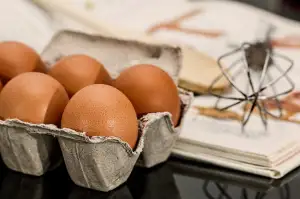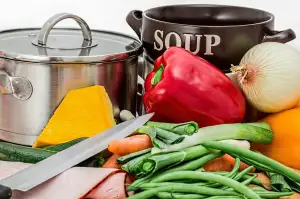Easter Delights: Discover the Mouthwatering Traditional Easter Foods to Savor

- Hot Cross Buns: A Symbolic Easter Treat
- Lamb: A Traditional Easter Main Course
- Easter Eggs: A Symbol of New Life
- Simnel Cake: A Rich and Fruity Easter Dessert
- Colomba Pasquale: Italy's Dove-Shaped Easter Bread
- Pashka: A Russian Easter Cheese Dessert
- Capirotada: A Mexican Bread Pudding for Easter
- Tsoureki: Greece's Sweet Easter Bread
Easter is a joyous celebration that brings together family and friends to commemorate the resurrection of Jesus Christ. Alongside religious observances, one of the highlights of Easter is the delectable array of traditional foods that are enjoyed during this festive season. From sweet treats to savory dishes, these culinary delights hold special significance and add flavor to the Easter festivities. Let's take a mouthwatering journey through some of the most iconic Easter foods from around the world, each with its own unique history and symbolism. Get ready to tantalize your taste buds as we explore these delightful Easter treasures!
Hot Cross Buns: A Symbolic Easter Treat
Hot Cross Buns, with their distinctive cross on top, are a beloved Easter treat that holds deep symbolism. These sweet and spiced buns have been enjoyed during the Easter season for centuries. The cross represents the crucifixion of Jesus, making them a reminder of the religious significance of Easter. Traditionally made with raisins or currants, these soft and fluffy buns are often flavored with cinnamon, nutmeg, and allspice. Hot Cross Buns are typically enjoyed on Good Friday, but they can be found in bakeries throughout the Easter period. So, don't miss out on this symbolic and delicious Easter treat!
Lamb: A Traditional Easter Main Course
One of the most iconic and traditional Easter main courses is lamb. This succulent meat holds great significance in many cultures and is often associated with religious symbolism. The tradition of serving lamb during Easter dates back centuries and can be traced to various historical and cultural influences.
In Christian traditions, lamb symbolizes purity and sacrifice, representing Jesus Christ as the "Lamb of God." It is believed that the association between lamb and Easter originated from the Jewish Passover, where a sacrificial lamb was consumed during the feast. As Christianity emerged, this symbolism carried over into Easter celebrations.
Different countries have their unique ways of preparing lamb for Easter. In Mediterranean countries like Greece and Italy, roasted or grilled lamb is a popular choice. The meat is marinated with aromatic herbs and spices, giving it a distinctive flavor. In some regions of Spain, a whole roasted lamb called "Cordero Lechal" is a centerpiece dish for Easter feasts.
In other parts of the world such as England and Australia, roast leg of lamb with rosemary and garlic is a traditional favorite. The tender meat is served alongside roasted vegetables and mint sauce for a delightful combination of flavors.
Not only does lamb hold cultural significance during Easter, but it also offers nutritional benefits. Lamb is an excellent source of protein, vitamins B12 and B6, iron, zinc, and omega-3 fatty acids. Its rich flavor pairs well with various side dishes such as potatoes, spring vegetables, or couscous.
Whether you prefer your lamb roasted to perfection or cooked in a flavorful stew, including this traditional main course on your Easter menu will surely delight your taste buds while honoring age-old customs.
Easter Eggs: A Symbol of New Life
Easter eggs have long been a symbol of new life and rebirth, making them an integral part of Easter celebrations around the world. The tradition of decorating eggs for Easter dates back to ancient times when eggs were seen as a representation of fertility and the beginning of spring.
In many cultures, eggs are dyed in vibrant colors and intricately decorated with patterns and designs. This practice symbolizes the joy and hope that comes with the arrival of spring and the resurrection of Jesus Christ.
The most common method of dyeing eggs is by using natural ingredients such as onion skins, beetroot, or spinach leaves to create beautiful hues. Some cultures also use wax or melted crayons to create intricate designs on the eggs before dyeing them.
Easter egg hunts are another popular tradition associated with Easter eggs. Children eagerly search for hidden eggs in gardens or parks, adding an element of excitement to the festivities. These hunts not only bring joy but also reinforce the symbolism behind Easter eggs as a representation of new life.
In addition to their symbolic significance, Easter eggs are also enjoyed as delicious treats. Chocolate eggs, often filled with candies or small toys, have become a favorite among children and adults alike. These sweet surprises add an extra layer of delight to Easter celebrations.
Whether they are beautifully decorated or simply enjoyed as tasty treats, Easter eggs continue to hold a special place in our hearts during this festive season. They remind us of the beauty and wonder that comes with new beginnings and serve as a joyful reminder of the hope that Easter brings.
Simnel Cake: A Rich and Fruity Easter Dessert
Simnel cake is a rich and fruity Easter dessert that has been enjoyed in the United Kingdom for centuries. This traditional cake is typically made with a light fruitcake base, filled with marzipan, and topped with eleven marzipan balls to represent the twelve apostles (minus Judas). The word "simnel" is believed to come from the Latin word "simila," which means fine flour.
The cake's origins can be traced back to medieval times when it was customary for girls working away from home as domestic servants to visit their families on Mothering Sunday. They would bring a simnel cake as a gift for their mothers, and it became associated with this special day.
The recipe for simnel cake has remained largely unchanged over the years. It includes ingredients such as dried fruits like currants, raisins, and candied peel, along with spices like cinnamon and nutmeg. The fruitcake batter is mixed together and then divided into two layers. A layer of marzipan is placed in the middle before baking.
Once baked, the cake is traditionally decorated with more marzipan. The marzipan balls on top symbolize the apostles, while some people also choose to decorate the sides of the cake with a woven lattice pattern made from marzipan strips.
Simnel cake is often served during Easter celebrations as a sweet treat after a meal or enjoyed with afternoon tea. Its rich flavors and dense texture make it a delightful indulgence during this festive time of year.
Whether you choose to bake your own simnel cake or purchase one from a bakery, this traditional Easter dessert is sure to delight your taste buds and add a touch of history to your holiday celebrations.
Colomba Pasquale: Italy's Dove-Shaped Easter Bread
Colomba Pasquale, meaning "Easter Dove" in Italian, is a traditional Easter bread that holds great significance in Italy. This dove-shaped sweet bread is typically enjoyed during the Easter season and is considered a symbol of peace and resurrection.
The origins of Colomba Pasquale can be traced back to the 1930s when it was created by a renowned Italian baker. The shape of the bread represents the Holy Spirit descending like a dove, while its rich ingredients symbolize abundance and renewal.
Made from a soft dough enriched with butter, eggs, and candied fruits, Colomba Pasquale is often topped with pearl sugar and almonds before being baked to perfection. The bread's texture is light and fluffy, similar to that of panettone or brioche.
Traditionally, Colomba Pasquale is prepared using a lengthy process that involves multiple risings to ensure its distinctive flavor and texture. It takes several hours to make this delectable treat, making it all the more special for Easter celebrations.
In Italy, Colomba Pasquale is commonly exchanged as a gift between friends and family during Easter gatherings. It serves as both a delicious dessert and a symbol of goodwill. Many families also enjoy it alongside other traditional Italian Easter dishes such as lamb or artichokes.
Whether enjoyed fresh out of the oven or toasted with butter, Colomba Pasquale offers a delightful combination of flavors and textures that are sure to please any palate. Its unique shape and symbolism make it an integral part of Italian Easter traditions, adding joy and sweetness to this festive occasion.
Pashka: A Russian Easter Cheese Dessert
Pashka is a traditional Russian Easter dessert that holds great significance in the country's culinary traditions. This rich and creamy cheese dessert is typically made with farmer's cheese, butter, sugar, eggs, and various dried fruits and nuts. Pashka is shaped into a pyramid or a dome and decorated with religious symbols like the letters XB (which stands for "Christ is risen") or a cross. It is usually served alongside another Russian Easter treat called kulich, a sweet bread. Pashka represents the joy of resurrection and new life, making it an essential part of Easter celebrations in Russia.
Capirotada: A Mexican Bread Pudding for Easter
Capirotada is a traditional Mexican bread pudding that holds a special place in Easter celebrations. This unique dessert is made with layers of toasted bread, cheese, nuts, and dried fruits, all soaked in a sweet syrup made from piloncillo (unrefined cane sugar), cinnamon, and cloves. The ingredients used in capirotada hold symbolic meaning: the bread represents the body of Christ, the syrup signifies his blood, the cheese represents the Holy Eucharist, and the nuts and dried fruits symbolize the bitterness of Christ's suffering. Capirotada is typically served during Lent and especially on Good Friday as a delicious way to honor this religious holiday. Its rich flavors and textures make it a delightful treat to savor during Easter festivities.
Tsoureki: Greece's Sweet Easter Bread
Tsoureki is a traditional Greek Easter bread that holds a special place in the hearts of Greeks during the Easter season. This sweet, aromatic bread is made with a rich dough flavored with orange zest and ground mahlepi, a spice derived from cherry seeds. It is often braided into a beautiful, twisted shape, symbolizing the Holy Trinity.
The preparation of Tsoureki involves several steps, including proofing the yeast, kneading the dough to achieve the perfect texture, and allowing it to rise before baking. Once baked, Tsoureki is typically adorned with colorful dyed eggs and sprinkled with sesame seeds or almonds for added flavor and visual appeal.
Tsoureki is not only delicious but also carries deep symbolism. The bread represents the body of Christ, while the red-dyed eggs symbolize his blood and resurrection. It is customary for Greeks to break their Tsoureki together after midnight on Easter Sunday as a sign of unity and renewal.
This delightful treat is enjoyed throughout Greece during Easter festivities. Families gather around the table to share slices of Tsoureki along with other traditional Easter foods. Its soft texture and sweet aroma make it a favorite among both young and old.
Whether enjoyed plain or toasted with butter, Tsoureki provides a delightful taste experience that captures the essence of Greek Easter traditions. Its unique blend of flavors makes it an irresistible treat that truly embodies the spirit of this joyous holiday.
So this Easter season, why not embrace Greek tradition by savoring a slice of Tsoureki? Indulge in its sweetness and let its symbolic significance add meaning to your celebrations.
Easter is a time of celebration and joy, and what better way to mark this special occasion than with delicious food traditions? From hot cross buns to lamb dishes, Easter eggs to rich desserts, there are so many mouthwatering treats to savor during this festive season.
By indulging in these traditional Easter foods, we not only satisfy our taste buds but also connect with centuries-old customs that have been passed down through generations. These culinary delights symbolize the significance of Easter and bring families and communities together in celebration.
Whether you prefer the spiced sweetness of hot cross buns or the succulent flavors of roasted lamb, each dish has its own unique story and symbolism. The hot cross bun represents the crucifixion of Jesus, while lamb signifies sacrifice and renewal. Easter eggs are a symbol of new life and resurrection, while desserts like Simnel Cake, Colomba Pasquale, Pashka, Capirotada, and Tsoureki add a touch of sweetness to the festivities.
These traditional Easter foods are not just delicious; they also provide a sense of cultural identity and heritage. Each country has its own unique twist on these dishes, showcasing their culinary traditions and regional flavors. Whether it's Italy's dove-shaped bread or Russia's cheese dessert, these specialties reflect the diversity and richness of global food culture.
So this Easter season, let us embrace these delightful food traditions and celebrate with our loved ones. Let us savor the flavors that have stood the test of time and appreciate the stories behind each dish. By doing so, we not only fill our bellies but also nourish our souls with the joyous spirit of Easter.
Published: 12. 02. 2024
Category: Recipes



